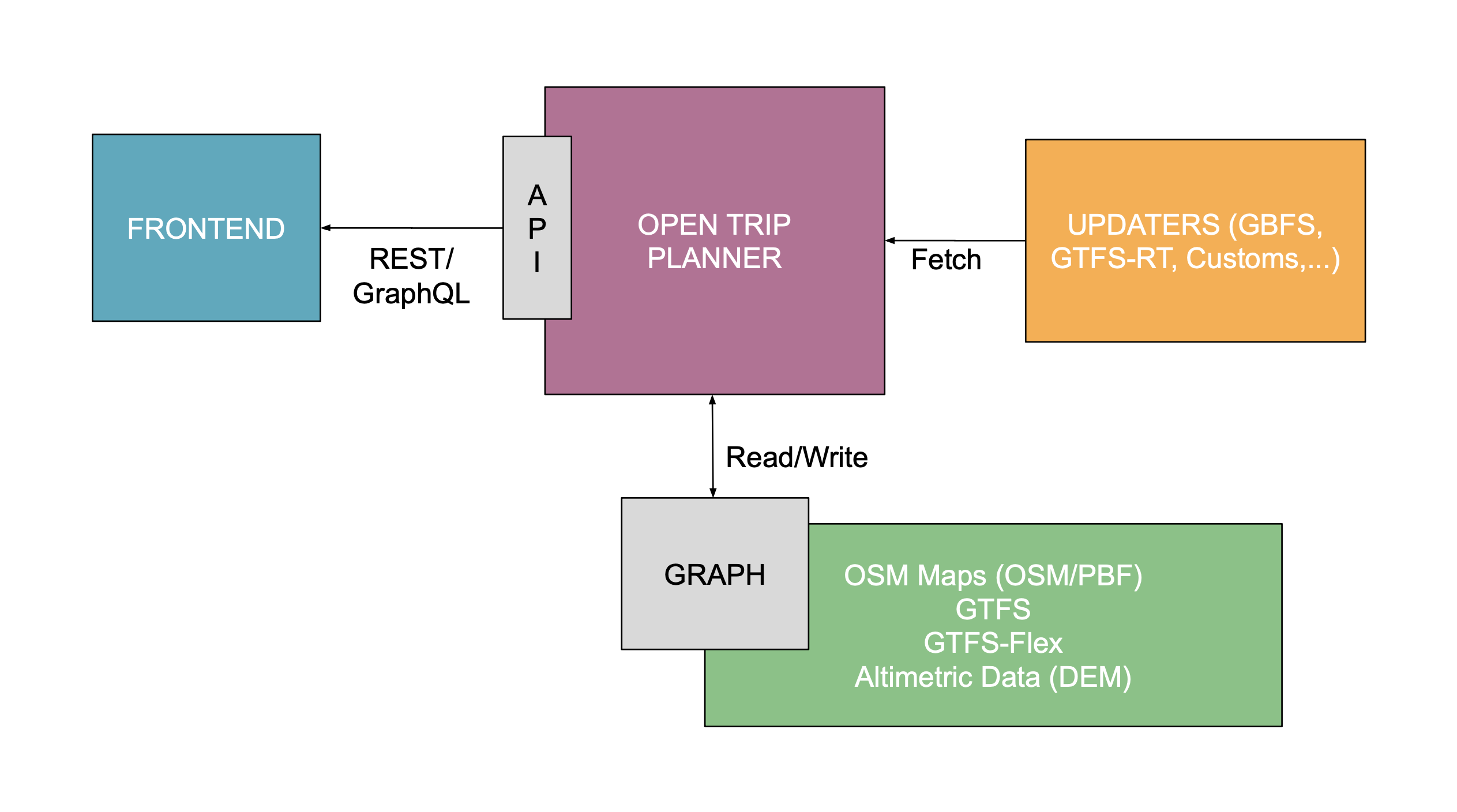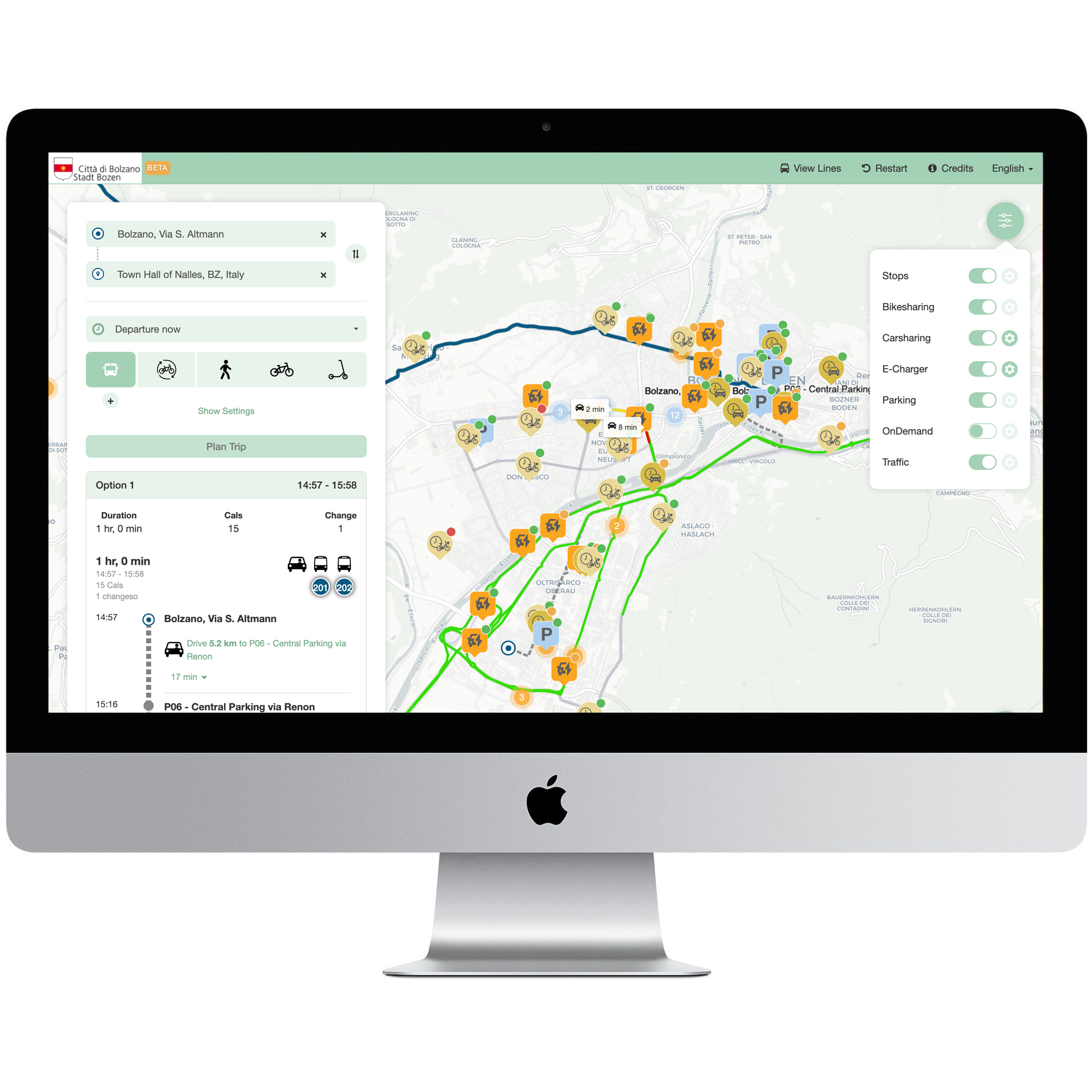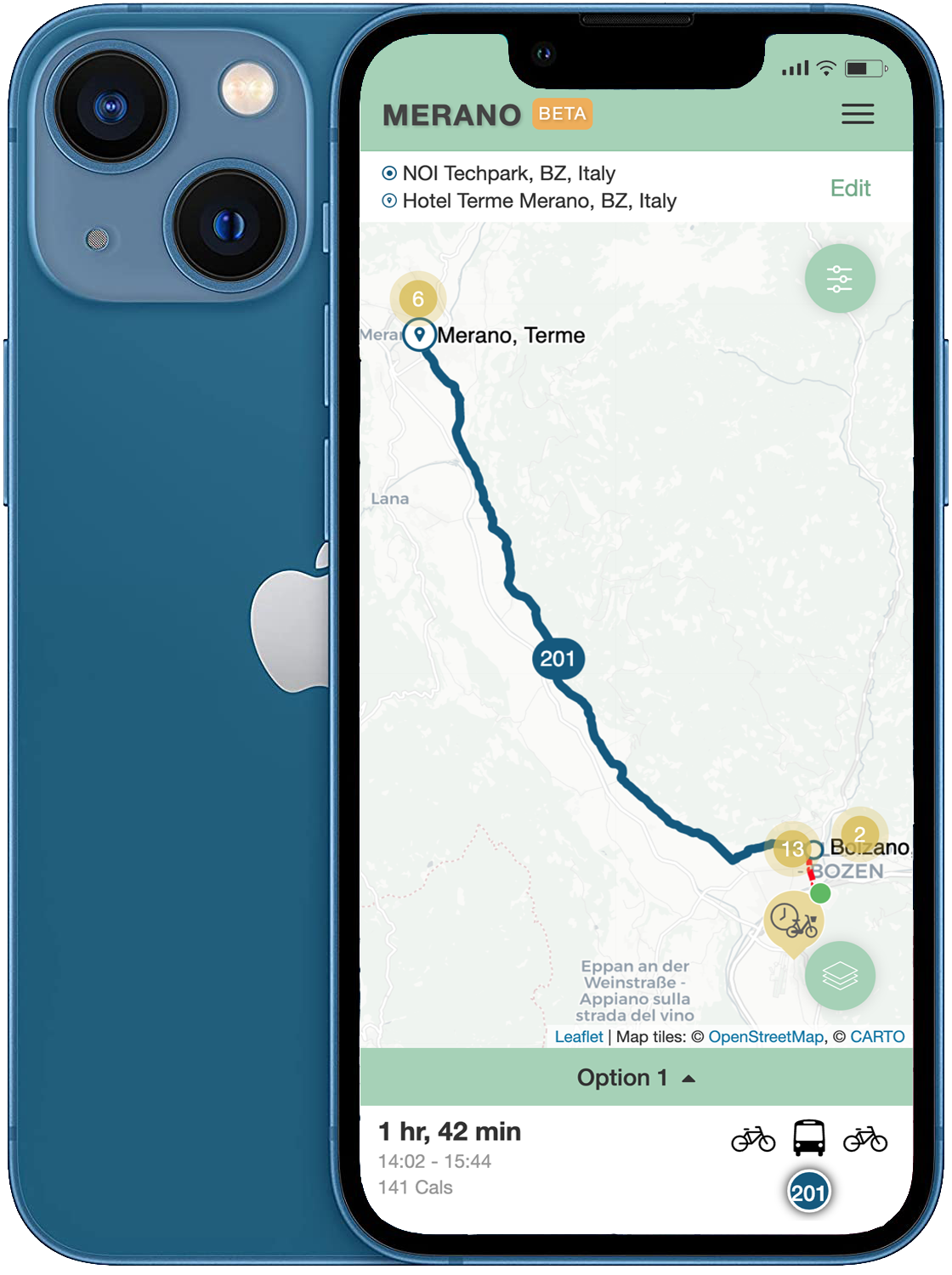The challenge we have taken up is the creation of the South Tyrol passenger information platform, which is divided into the following four main activities:
- integration of data and mobility services of the territory;
- implementation of the journey planning engine;
- release of APIs for the use by third parties;
- development of the highly configurable front end portal in terms of layout and functionalities.
The work is part of the MENTOR project, funded by the Interreg-V-A Italy-Switzerland program, coordinated by the Municipality of Merano and carried out in collaboration with NOI Techpark, SASA, the Municipality of Brig-Glis in the Canton of Valais and Postauto. The goal of the project, which started at the end of 2018, is to demonstrate the potential of “Mobility-as-a-Service” (MaaS) in the two pilot municipalities, representative of the Alpine environment.
NOI (the in-house agency of the Autonomous Province of Bolzano in charge of stimulating research activities, promoting scientific innovation and acting as a reference point for Information Technology in the South Tyrolean territory) intends to invest in MaaS to reduce the use of cars private sector in favor of more sustainable modes of transport, in line with its mission to develop new products and services, generating widespread value on the territory and across borders.
The initial context of this project featured the following requirements:
- the availability of data in the so-called Open Data Hub, an open data aggregator that aims to support the implementation of innovative platforms for the province of Bolzano;
- the will to focus on open source technologies supported by a strong developer community: OpenTripPlanner for intermodal route calculation, Pelias for geocoding and Docker for the deployment of the solution;
- the desire to replace the previously used portal to take advantage of the new features available, improving the user experience, allowing easier integration of additional information and optimizing data exchange in order to minimize client-side processing and make the application efficient even in the case of hardware with limited performance.
Particular attention was paid to the specificities of the South Tyrolean territory, a border region between Italy and Austria with a strong tourist presence and therefore with the natural predisposition to Italian, German and English trilingualism.
The platform amounts to a Level 1 MaaS solution, which – according to the MaaS topology – considers the systematization of multiple transport services featuring passenger information and route planing and that represents the starting point for possible evolutions towards Level 2 MaaS scenarios, which also integrate booking and payment functionalities, and Level 3, which also include fare integration.
The new user portal integrates a number of passenger information features, in particular:
- an intermodal journey planner, with the ability to customize searches through a series of highly configurable settings;
- a rich interactive map with different levels of data visualization, optimized for the specific transport services considered in the project;
- dynamic timetables to show arrivals at the stop in real time.
Fundamental to the success of a MaaS project are effective intermodality and real-time characteristics, which allow the ridership to rely on a complete and reliable travel companion.
The project developed by OpenMove, based on these cornerstones, is structured upon the following components visible in the figure.

A well-known open source intermodal journey planning engine has been adopted, namely OpenTripPlanner (OTP), which is already in use by multiple mobility information providers worldwide.
OTP is able to acquire numerous types of transport service data as inputs:
- Public transport (GTFS and GTFS-Realtime format)
- Bike sharing and other micromobility sharing services (GBFS format)
- On-demand transport (GTFS-Flex format)
The application uses maps that describe the road network of a given area in the form of files in OpenStreetMap format (OSM/PBF) and digital elevation model (DEM) to elaborate more detailed walking or cycling routes.
Furthermore, some additional modules have been built to make possible the integration of real-time data from:
- Parking facilities
- Parking sports monitored by IoT devices
- Car sharing services
Thanks to the numerous endpoints exposed by the REST API and the GraphQL functionality, it is possible to consult the transport data processed, plan a route or generate isochrones. Therefore, thanks to the APIs developed by OpenMove, it is also feasible to create new front ends dedicated to specific needs or to certain areas and contexts: for example, a planner for cycle routes only or a portal that focuses on the city’s electric mobility.
The realization of this solution, now available at the addresses mobility.meran.eu and mobility.bz.it, made us reflect on the following lessons learned:
- The user is at the center of the mobility scenario
A uniform and consistent user-centered design approach led to an improvement in the user experience and performance of the application compared to the previous solution, optimizing UX and UI for mobile use and for impaired users. There are multiple display layers that can be activated and deactivated at will and many configuration options of the route calculation engine, so as to allow users great flexibility in planning the route. The new portal also improves multilingual support, in order to make the solution expandable and easy to use even in tourist contexts. - The importance of data standards for modeling transport services
Designing a MaaS platform nowadays requires considerable architectural work to ensure scalability in the addition of new transport services, flexibility in considering different use cases, increase of the usage volume and extension of the geographical perimeter.
The most widely used de facto standards on the market (GTFS, GTFS-Realtime, GTFS-Flex, GBFS) are sufficiently extended and flexible to cover the description of all the mobility services currently present in modern cities: their native availability and support therefore enables quick integrations and effective implementations. - Intermodality and real-time fruition are the cornerstones of tomorrow’s sustainable mobility
The solution aggregates a large variety of fully integrated transport services into a single platform, thus allowing effective intermodality (i.e. considering modal changes within the route):
○ bus
○ train
○ personal bike
○ car sharing
○ bike sharing
○ on-demand service
○ EV charging
○ e-scooters
○ parking on the street and in facilities
For example, park&ride scenarios are considered (i.e. the use of the car to reach the train or the bus station): it is an interesting case because the platform combines traffic data, real-time parking availability and estimated time of arrival of the train. In the case of bike&ride, the system considers the availability in real time at the bike sharing stations and favors the safest roads for two wheels.
Ultimately, the South Tyrol intermodal passenger information platform created by OpenMove represents one of the most advanced solutions available on the market today.
A particular consideration deserves the choice of open source within this project. Our tech team contributes to the development of open source technologies on a regular basis, taking advantage of the large developers community already active in the smart mobility sector.
Proud of the results achieved, we decided to share a glimpse of our technology, releasing the source code of the portal and of the integration modules on a public repository (available at this address) with an open license, so that many other entities can enhance their passenger information solutions or contribute to the enrichment of the functionalities of our project.



